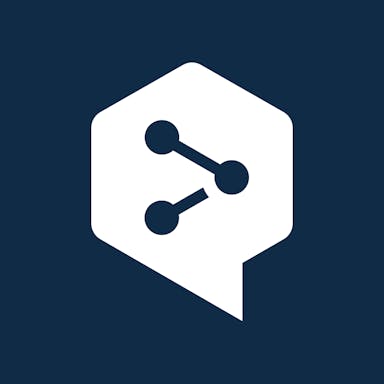Thesis
As the world becomes increasingly interconnected, the ability to communicate across languages has only become more essential and the demand for high-quality language translation has never been higher. Organizations increasingly recognize the need to communicate across borders and cultures. Businesses have to communicate with their clients, suppliers, and partners in different countries, and these communications must be accurately translated to ensure that the intended message is conveyed.
A company that can communicate effectively in the language of its customers or partners will be better positioned to succeed in the global marketplace. Language translation can help companies to reach new markets, expand their customer base, and establish themselves as global players in their industry The global language services market was valued at $60.7 billion in 2022 and is projected to reach $96.2 billion by the end of 2032. Advancements in technology have made language translation more accessible, easier, and cheaper than ever before, and the global language translation software market in particular was valued at $9.3 billion in 2021 and is projected to reach $44.8 billion by 2031.
DeepL is a machine translation platform that instantly translates written content accurately and effortlessly into different languages. DeepL's advanced neural networks capture linguistic nuances and deliver real-time translations that sound human. Over 20K businesses and 1 billion users globally use DeepL through desktop and mobile apps, a browser extension, API integration, or the DeepL website.
Founding Story
Although DeepL officially became a company in late 2017, the foundational product and original company were started 10 years earlier. In 2009, former Google research scientist Gereon Frahling founded one of the best multi-language dictionaries on the market called Linguee. It had the language pairs English-German, English-French, English-Spanish, and English-Portuguese since 2010 and provided translations for words and phrases in various languages. DeepL founder Jaroslaw Kutylowski was the CTO at Linguee from 2012 to 2017.
While trying to improve Linguee, researchers at the company started using neural networks to improve their verification process for different translations. They then started using the technology for different applications. A team led by Jaroslaw Kutylowski started training a neural network to do machine translations on the dataset they had spent the last 10 years curating, and went on to announce the launch of DeepL, an online machine translator, in 2017. In July 2019, DeepL announced the appointment of Jaroslaw Kutylowski as CEO.
Product
DeepL Translate
DeepL’s translation product uses a deep neural network architecture called a Transformer. The Transformer model is designed to overcome some of the limitations of earlier neural machine translation models (like RNNs) and has been shown to be highly effective at capturing long-range dependencies and producing fluent and natural translations. This is because RNNs process input sequences sequentially (i.e. one word at a time) and the impact of earlier words on later words diminish as the sequence gets longer. On the other hand, the Transformer model uses a self-attention mechanism that allows it to attend to all words in a sentence simultaneously, capturing both local and global dependencies.
DeepL supports a multitude of languages including Bulgarian, Chinese, Czech, Danish, Dutch, English, Estonian, Finnish, French, German, Greek, Hungarian, Indonesian, Italian, Japanese, Latvian, Lithuanian, Polish, Portuguese, Romanian, Russian, Slovak, Slovenian, Spanish, Swedish, Turkish, and Ukrainian. It has Mac, iPhone, iPad, Windows, ChromeOS, and Android applications.
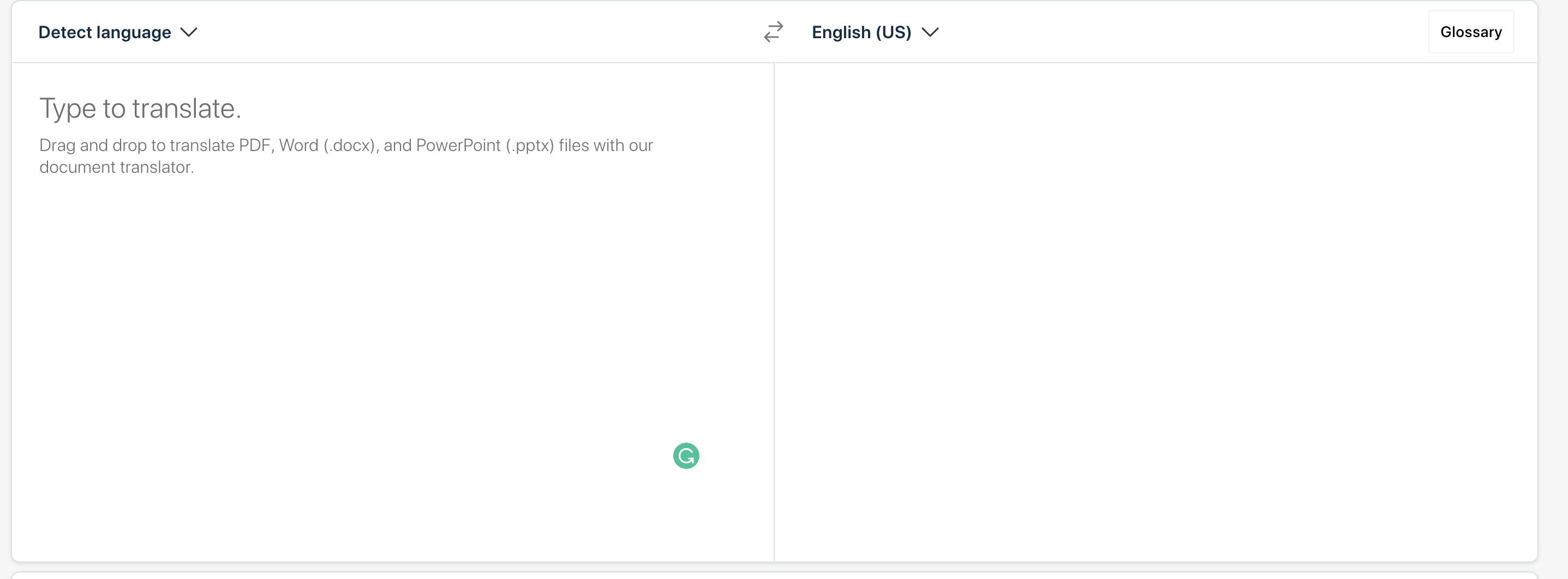
Source: DeepL
DeepL Write
DeepL Write, announced in January 2023, is an AI writing tool that improves written communication in English and German. It tackles grammar and offers suggestions on phrasing, tone, style, and word choice. DeepL Write is available on desktop and mobile browsers.
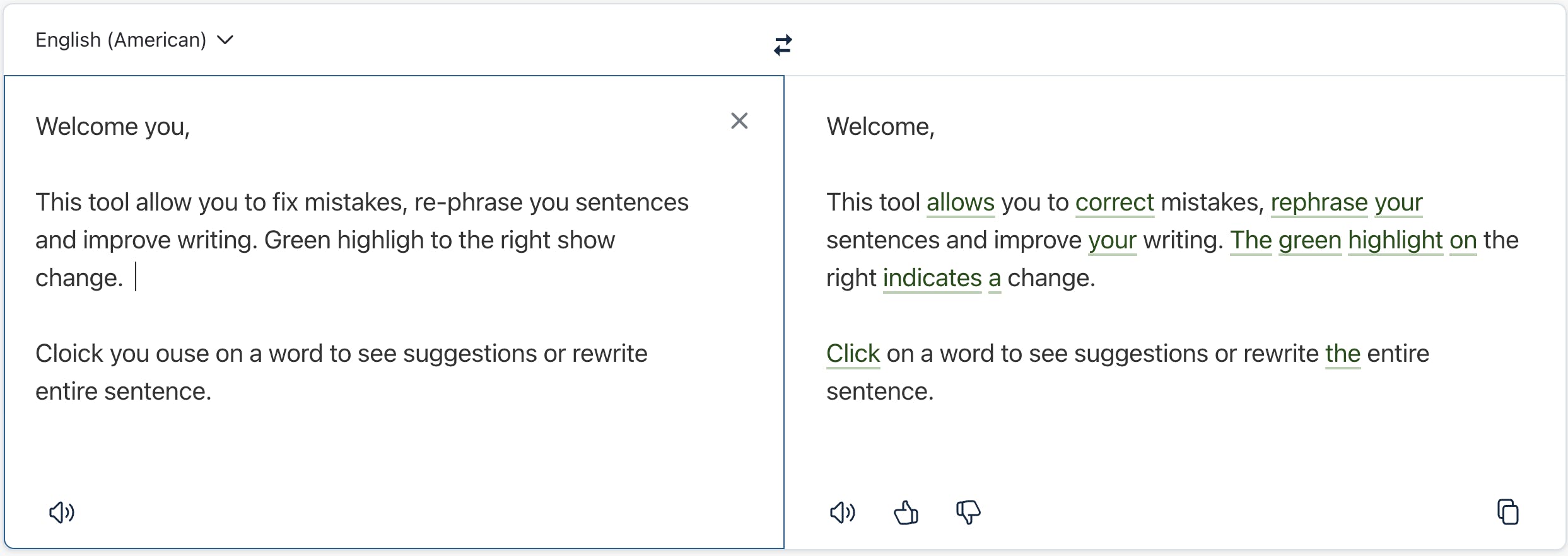
Source: DeepL
Translation API
DeepL enables developers to use its JSON-based REST API to embed its machine translation technology directly into their products and platforms. Companies can use its API to translate text in browsers, chat programs, email clients, or word processors. It enables the translation of Word, PowerPoint, PDF text, and HTML files. Users can choose the tone of translations for languages with formal/informal pronouns and limit the maximum monthly usage-based costs with monthly cost control. Users can also specify how words and phrases are translated by creating their Glossary. Use cases include internal communications, live translation apps, and augmented reality translations.
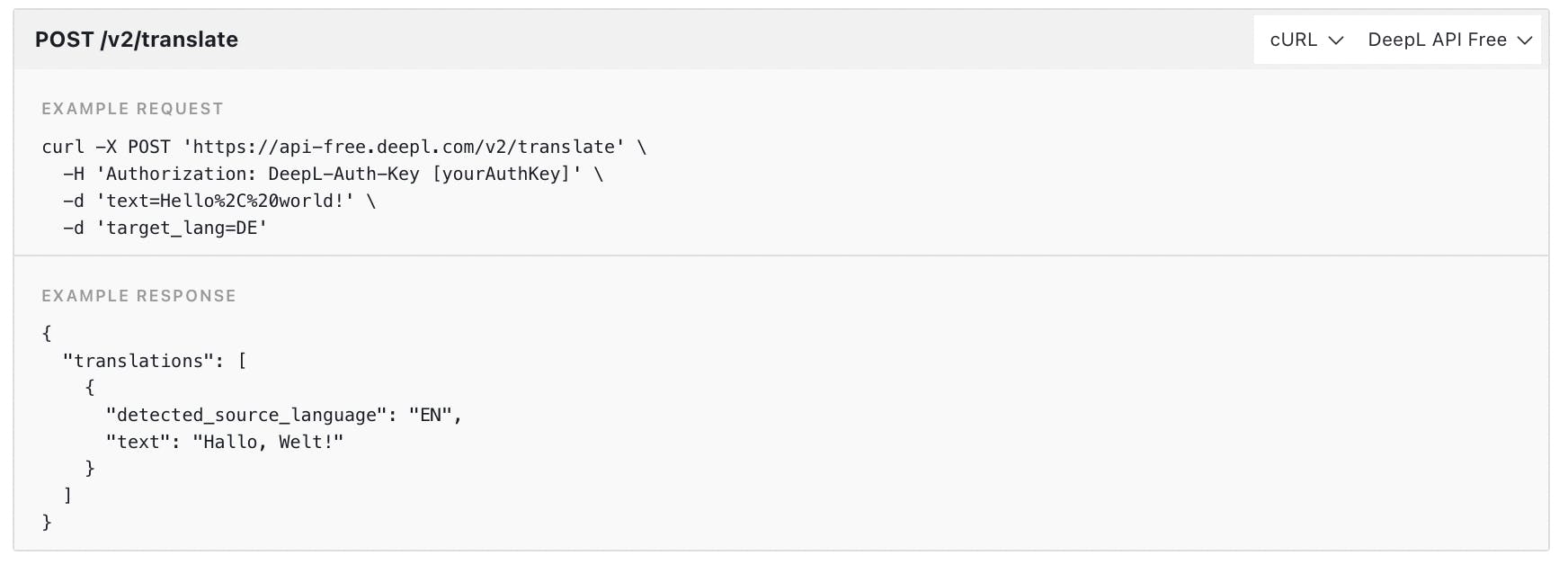
Translation API
Market
Customer
DeepL’s customer base is split into consumers and businesses. Consumers can use the free translator tool the way they use Google Translate.
On the B2B side: there are three core customer segments.
Enterprises: Companies use it to communicate with customers, partners, and employees in different languages.
Language service providers (LSPs): LSPs specialize in providing translation and interpretation services to other businesses or individuals.
Developers: Developers use DeepL's API to integrate machine translation services into their applications or software products.
Market Size
The global language services industry brings in $26.6 billion a year. The global language translation software market was valued at $9.3 billion in 2021 and is projected to reach $44.8 billion by 2031.
DeepL is moving away from being just a translation service and more of an AI company that focuses on text. Their latest product, Write, is aimed at taking on Grammarly, valued at $13 billion by just focusing on being a writing assistant for the English language.
Competition
Unbabel - Unbabel is a language translation platform combining artificial intelligence with human translators to provide fast and accurate scaled translations. It was founded in 2013. Point 72 Ventures led their $60 million Series C to bring total funding to $91.2 million.
Lilt - Lilt is another language translation software company. It was founded in 2015 and has raised $92.5 million in funding. Lilt uses a combination of human translators and an AI translation engine. It supported 40 languages as of April 2022.
Google - Google Cloud’s Cloud Translation enables companies to have their websites and applications dynamically translate text programmatically through an API. It uses Google’s Neural Machine Translation model, which Google updates on a regular cadence when more training data or better techniques become available. It can translate text for more than 100 language pairs. Its AutoML Translation lets developers create custom translation models. These custom models return results from translation queries specific to specific domains. Google Translate, the consumer-focused translation service from Google, released its Android app in January 2010, just over a year after the first commercial Android device was launched. In 2021, Google translate hit 1 billion downloads. It comes with DeepL’s free translator for consumer reach, mindshare, and usage.
Microsoft - Microsoft offers language translation through Microsoft Translator, which has both consumer and business offerings. Custom Translator is a feature of the Microsoft Translator service which enables enterprises, app developers, and language service providers to build customized neural machine translation (NMT) systems.
Amazon - Amazon offers Amazon Translate, a neural machine translation service that delivers fast language translation. It supports 75 languages. With Active Custom Translation (ACT), Amazon Translate allows developers to take greater control over machine-translation output by letting them bring their data to Amazon Translate to customize the machine-translated output to suit their needs. ACT produces custom-translated output without the need to build and maintain a custom translation model.
Business Model
DeepL uses a freemium business model that funnels users into paid tiers. The free tier limits the number of characters a user can translate at once, the security of the user’s data, the number of documents they can translate a month, the number of glossaries they can have, and the integrations allowed. The free tier for the DeepL API, which has access to the same features, is less restrictive, allowing access to more glossaries and more translations.
DeepL Pro is for individuals and teams and has three tiers that charge per user per year: the starter tier costs $104.88/year, advanced is $344.88/year, and ultimate is $689.88/year. They also have enterprise pricing for teams larger than 10 people, which businesses need to contact sales for.
DeepL API Pro, which offers fewer restrictions and more functionality, charges users on a monthly basis of $5.49/month or $65.88/year plus $25.00 per 1 million characters translated.
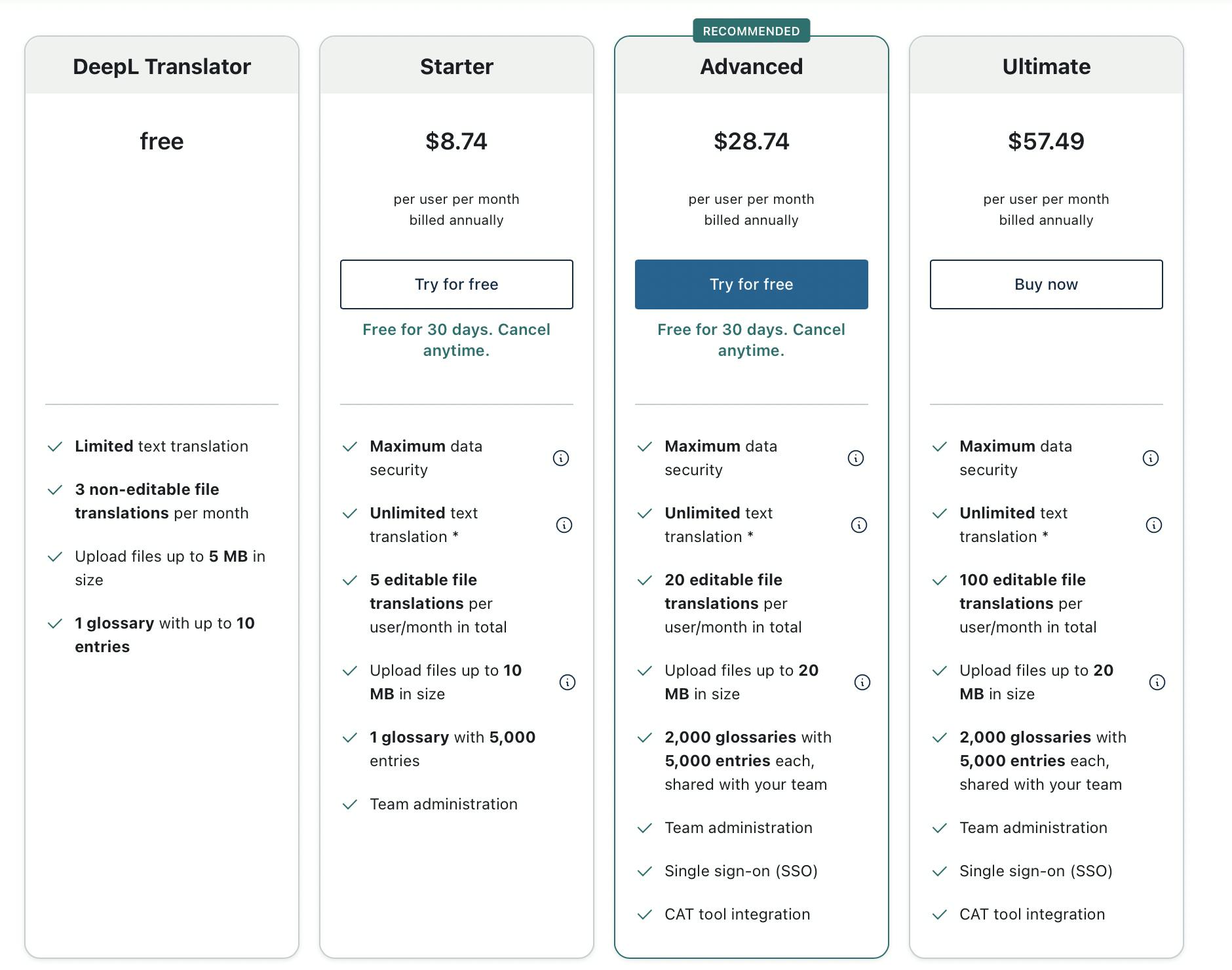
Source: DeepL
Traction
Over one billion people have used DeepL’s services. In late 2021, they were the 9th most visited website in Switzerland, the 30th most visited website in Japan, and the 146th most visited site in the world. 20K businesses around the world use DeepL. It supports 31 languages, and its annual run rate was $50 million at the end of 2022.
Valuation
DeepL announced it had raised over $100 million in January 2023 at a $1 billion valuation led by IVP.
Key Opportunities
More Languages
For each additional language DeepL adds, it has an opportunity to upsell existing customers as well as add larger enterprises with big contracts. It’s important to do this as fast as possible because it’s hard to get large enterprises to switch their translation engines.
Tackling an Adjacent Market
DeepL is currently coming out with its Grammarly competitor, Write. Grammarly, going after only English speakers, has attained a $13 billion valuation, with 30 million people using it a day. DeepL is poised to create the same product for each of the 31 languages it currently supports. If Write starts being adapted more globally, it could be a new source of revenue in a domain that has been less competitive than direct machine translation.
Key Risks
Bundling
Despite millions of users, many customers and businesses they are going after are using one of Google, Microsoft, or Amazon’s cloud services. DeepL has historically performed better enough on translations for businesses to justify using DeepL over a platform like Google Cloud, even if that business already uses Google Cloud for other services. However, the moment DeepL’s edge in translation becomes less distinct, it could lose more enterprise customers because it is easier for the business to go with the offering on the platform the business is already on.
Lack of Defensibility
When DeepL was getting started, its technological moat lay partially in the curated and high-quality data it got from the multilingual dictionary it spent the last couple of years on. Now, that moat is largely gone. This puts more pressure on DeepL’s ability to build the best transformer, which is one of the company’s primary technological moats.
Summary
DeepL is an AI-powered machine translation company with the goal of making communication and translation seamless for individuals and businesses. After originally being founded as a multilingual dictionary, Linguee, the company pivoted to full machine translation after discovering how accurate translations were on their data with the new transformer technology. Producing one of the best machine translation models in a very competitive market, they now have their sights set on disrupting the multi-billion dollar AI-powered writing assistant market for each of the languages they offer.
